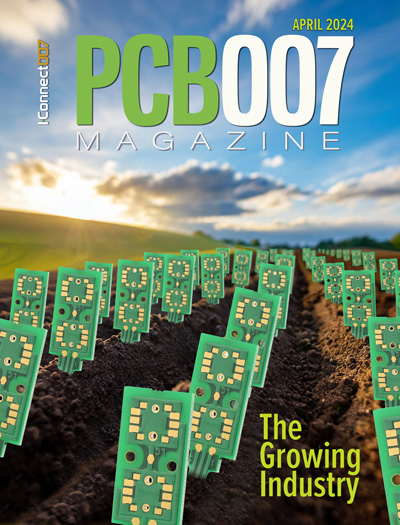-

- News
- Books
Featured Books
- pcb007 Magazine
Latest Issues
Current Issue
The Growing Industry
In this issue of PCB007 Magazine, we talk with leading economic experts, advocacy specialists in Washington, D.C., and PCB company leadership to get a well-rounded picture of what’s happening in the industry today. Don’t miss it.

The Sustainability Issue
Sustainability is one of the most widely used terms in business today, especially for electronics and manufacturing but what does it mean to you? We explore the environmental, business, and economic impacts.

The Fabricator’s Guide to IPC APEX EXPO
This issue previews many of the important events taking place at this year's show and highlights some changes and opportunities. So, buckle up. We are counting down to IPC APEX EXPO 2024.
- Articles
- Columns
Search Console
- Links
- Events
||| MENU - pcb007 Magazine
Logistics Are Frank Lorentz’s Passion
January 21, 2020 | Barry Matties, I-Connect007Estimated reading time: 14 minutes
Recently, I had the chance to visit Ventec International Group’s German facility in Kirchheimbolanden (KIBO), where I met Frank Lorentz, Ventec’s general manager for the location. Logistics are clearly Frank’s passion. He lives and breathes it. If you spend any amount of time with him, that is abundantly clear.
The interesting thing about Frank is that his background is in the newspaper business, not the PCB business. His career is logistics, and he is very good at it. As Frank said, in the newspaper business, if you are a day late with your product, then it’s only good for wrapping fish. He brings that thinking into the laminate distribution business.
Efficient communication is key for logistics, so Frank starts each morning with a five-minute team meeting. This is a standing, no-chairs meeting that’s long enough to understand the priorities of the day and pass on the information everyone needs. As Frank explained, it’s important that everybody understands what everybody else is doing.
When you walk through the Ventec facility with Frank, he uses the word “standard” over and over: process, products, and packaging standards, etc. As he says, “Making it efficient is one thing, and making certain the processes work is equally important. That’s the job we have to do, and no standard is good if it isn’t realized.”
Frank has created a culture of continuous improvement. It starts from the moment a new employee is hired. They will spend their first week working on the shop floor, regardless of their position. Frank said, “We have a continuous process improvement culture with lots of small steps. We recently passed the re-certification audit for our ISO 9001 approval with no non-conformances. Our systems have been ISO 9001:2015 certified since 2016. It recognizes our entire team’s hard work and the success of our quality strategy for the benefit of all our customers, and that supplements the company’s main manufacturing site certifications of AS9100 Rev D and IATF 16949:2016.”
The following is an interview with Frank, which was conducted after our tour of the KIBO site.
Barry Matties: Frank, let’s start with a quick overview of your background.
Frank Lorentz: I’m a logistics guy, and I started in 1997. In the past, I worked for Ingram Micro that did the logistics for Cisco Systems in Europe until it was closed. After that, I worked as a supply-chain manager for the biggest newspaper in Germany and then in the same industry with Germany’s largest newspaper distributor.
Matties: And you joined Ventec without an industry or laminate background, but you brought your logistics background. When you came into Ventec, what role were you hired for?
Lorentz: I started as a production manager and took over the logistics as well.
Matties: There are a lot of areas that a company can improve. When you come into an organization like this, what was your strategy?
Lorentz: First, you have to know how the machines are running. You have to create benchmarks to bring in the highest level of quality standards for everybody.
Matties: When you talk about benchmarks, you’re documenting the process and getting a performance metric, if you will, for each step of the process. How do you decide what the most important area is to tackle first?
Lorentz: To successfully and continuously improve processes, you need to know your products and processes, so I worked on every machine and task together with my colleagues to learn how to do it by myself. I looked at how heavy a package was, saw how the machine ran, and figured out what we could optimize to improve overall efficiency and quality.
Matties: You talked to the operators and learned the process flow as well as the knowledge of their frontline insight because they know what’s working well and what’s not. What were your goals, and how did you prioritize what areas to work on?
Lorentz: I worked alongside my colleagues at the machines, where we had the most orders, to learn what they were doing. I was actively involved in the whole process.
The key is always to focus on the customer and set key goals accordingly as to how we want to deliver the products in the right quality to the right customer and at the right time within the global network of Ventec, while also considering the local requirements of each region. All improvements and the priority of each will first and foremost be driven by customer requirements and our service promise to them.
Matties: Having that detail of information makes the business run smoother.
Lorentz: Absolutely. But what we have should be a standard in the business because we can’t send the wrong goods to our customers.
Matties: It’s efficient, and you save time and money.
Lorentz: And you ensure that you have the right goods in the right place; that’s the most important thing.
Matties: And the customer wins.
Lorentz: Ventec offers a wide range of materials which we can quickly deliver to our customers. We have two systems. For repeat customers, who always buy the same product in the same size, or for those that have a consignment stock, we receive it directly from our manufacturing plant in China or Taiwan in its original packaging. Of course, we also fulfill customer orders, where a customer, for example, might need specific volumes or sizes.
Matties: Sent from Ventec China to you?
Lorentz: Yes, from China or Taiwan. For customers needing a specific size or only five to 10 sheets, we can take the material in sheets and cut it to size according to the customer’s requirements.
Matties: You have the ability to tailor it to their needs.
Lorentz: Correct. There has been a huge change in the organization of our production. We have the ability to deliver quickly. If you call me in the morning, and I have the materials in stock, we can send them out on the same day. Our production is always one step ahead, so we’re able to respond to customer demands on short notice by preparing orders in advance rather than waiting until that day to get them ready. If something can be brought forward, we work it into our task schedule. This is not only efficient but also allows us to handle unexpected events or urgent requests because we’ve already done the jobs we promised for that day.
Page 1 of 2
Suggested Items
ZESTRON Welcomes Whitlock Associates as New Addition to their Existing Rep Team in Florida
04/19/2024 | ZESTRONZESTRON, the leading global provider of high-precision cleaning products, services, and training solutions in the electronics manufacturing and semiconductor industries, is thrilled to announce the addition of Whitlock Associates to its esteemed network of sales representatives.
Real Time with... IPC APEX EXPO 2024: AI Implementation at Omron
04/18/2024 | Real Time with...IPC APEX EXPOEditor Nolan Johnson and Omron Product Manager Nick Fieldhouse discuss the company's focus on AI implementation to enhance customer experience and results. They address programming challenges and how AI can help customers achieve better outcomes with less experience. Omron's AI is compatible with existing systems, facilitating easy upgrades.
Cadence Unveils Palladium Z3 and Protium X3 Systems
04/18/2024 | Cadence Design SystemsThe Palladium Z3 and Protium X3 systems offer increased capacity, and scale from job sizes of 16 million gates up to 48 billion gates, so the largest SoCs can be tested as a whole rather than just partial models, ensuring proper functionality and performance.
Ark Electronics Expands Global Manufacturing Factory Network in North America and Europe
04/17/2024 | PRNewswireElectronic Manufacturing Company Ark Electronics recently announced the expansion of its Global Factory Network with the addition of Electronics Manufacturing Service (EMS) capabilities in Mexico and Europe.
New Yorker, Geyer Electronic Sign New Distribution Agreement
04/16/2024 | New Yorker Electronics Co.New Yorker Electronics, global distributor of electronic components, recently announced a new franchised distribution agreement with Geyer Electronic. Geyer is an international manufacturer of Quart Crystals, Oscillators and Resonators.


